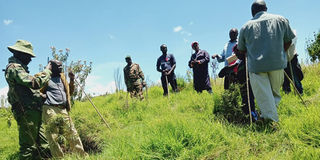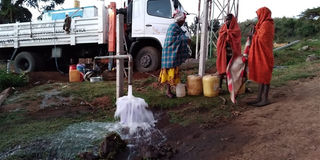How Narok County is building social and economic resilience to climate change
Sponsored by Narok County Government

Rehabilitation of Enosupukia Forest in Narok.
Background
The Earth is in grave danger, and so is tourism, thanks to climate change realities.
Kenya’s Intergovernmental Panel on Climate Change (IPPC) 2021 report says that it is “unequivocal” that human activity has warmed the atmosphere, ocean and land.
On September 8, 2021, President Uhuru Kenyatta declared a national emergency due to drought caused by two consecutive poor rainy seasons. The drought has been affecting the arid and semi-arid lands that make up approximately 80 percent of the country’s land area, indicating that the effects of climate change can easily spiral into a national catastrophe.
In the last 20-30 years, climate change has affected Narok County, located in the southwest of Kenya, with rainfall seasons becoming more unpredictable.
Climate change is impacting all sectors of Kenya’s economy, either directly or indirectly, just as it is affecting other global economies. This explains why there is also increasing global and regional support for climate-smart interventions.
Over the last three decades, residents of Narok County have continued to witness prolonged dry spells and droughts, negatively affecting crops and livestock. On the other hand, intense precipitation over short durations causes flash floods that end up destroying crops and property.
From October 31 to November 12, 2021, the world held the 26th UN Climate Change Conference of Parties (COP26) in Glasgow, and clearer roadmaps for climate change interventions were established.
Kenya remains a regional leader in developing comprehensive climate change policies and legislation. The country’s constitution devolves significant authority to 47 county governments. Vision 2030, the country’s principal development strategy, underscores adaptation to climate change effects for the nation to advance development and increase quality of life.
Subsequently, a number of policies seek to mainstream climate change into planning and implementation. They include the National Climate Change Response Strategy (NCCRS, 2010), the National Climate Change Action Plan (NCCAP, 2013-2017, 2018-2022), and the National Adaptation Plan (NAP, 2015-2030).
Adapting to climate change is a precondition to socio-economic development, especially in drought-prone regions largely dependent on small-scale agriculture and pastoralism. The Climate Change Act (2016) mandates counties to implement and monitor ambitious sustainable development and climate change goals.
The County Climate Change Fund (CCCF) is an important instrument. It consists of climate legislation enacted by county governments and a county-controlled fund to finance climate projects that are identified and prioritised by local communities.
Narok County Government is leveraging on these and more policies and legislation to help farmers and enterprises in the region to adapt to climate change effects, through support programmes.
Specific actions
The County Government of Narok, through the Department of Environment and Natural Resources, and stakeholders, enacted a climate change law and its regulations in February 2021. The main purpose of this law was to create a fund that would be used to avail resources for climate community-led actions, develop a structure of utilisation of the fund, as well as penalties on misuse.
This fund will also be used to spearhead projects aimed at research and mitigating weather hazards new to places they have never been witnessed before. For instance, emerging meteorological hazards in Narok have been characterised by increased frequencies of lightning, floods, droughts, frost, and hailstones.
The county government has invested in enhancing the utilisation of green energy by encouraging the use of solar power by communities, and by installing a 40MW Talek Mini grid. This has reduced the use of woodfuel in Talek region and its environs to a greater percentage. Consequently, it has led to reduced emissions, deforestation, increased efficiency, and several other social and environmental advantages.
Promoting resilient agribusiness
Climate change manifests itself primarily through erratic changes in the water cycle. Droughts, floods, rise in sea levels and storms intensify and become unpredictable, often with severe consequences.
The concurrent problems of hunger, ill-health linked to diet, food insecurity, threats from new diseases, and antimicrobial resistance, are rising among people living in poverty. These problems have been made worse in recent times by the Covid-19 pandemic. This is why the Narok County Government has put in place measures to cushion farmers and cater for food security interests. The county government has various initiatives under each agricultural programme, as follows:
1. Beef Value Chain Programme
This programme involves the use of appropriate pasture/fodder varieties (Boma Rhodes, Desmodium); and grazing land management (use paddocks and enclosures).
Additionally, there is an expansion of rangeland management that entails the promotion of range pastures (Cenchrus ciliaris, Maasai love grass); SNV Breed improvement; artificial insemination (AI); and use of fast-maturing breeds.
The programme also entails herd management, disease control, and integrated manure management (composting and manure collection). The programme covers the following:
- Pasture and fodder production
- Pest and disease control
- Breed improvement
- Beef finishing through feedlot technology
- Feed formulation.
2. Maize Value Chain Programme
To succeed in this, the Narok County Government has ensured there is stocking and selling of appropriate seed varieties for different zones; promotion of integrated pest management (use of pheromone traps); use of biopesticides; use of Aflasafe for aflatoxin control; application of conservation agriculture (minimum tillage, zero tillage, use of crop residues, crop rotation); encouraging the use of organic manure; downscaling of weather information; soil fertility management (soil testing); and use of appropriate fertilizers.
The programme entails the following:
- Conservation agriculture
- Postharvest management
- Climate-smart agriculture (CSA) technologies
- Appropriate and fertilizer application
- Integrated pest management.
3. Dairy Value Chain Programme
This programme constitutes breed improvement through the use of artificial insemination; appropriate pasture/fodder varieties (bracharia, fodder oats, Desmodium); water harvesting, storage and conservation (underground water tanks, roof water harvesting); manure management (composting and manure collection); downscaling of weather information (PSP); pest and disease control (vaccination, deworming, spray, tsetse surveillance); and postharvest management (use of aluminium cans, milk chilling). The specifics of the programme include:
- Breed improvement
- Pasture and fodder production
- Clean milk handling
- Milk value addition
- CSA and GG technologies
- Feed formulation.
Addressing the question of water

Finding water.
Climate change has direct consequences on water security and conflict. To achieve the Sustainable Development Goals, climate change adaptation requires building climate resilience, which can be attained through healthy ecosystem services that rely on well-functioning river basins. Effective county-driven climate change adaptation should reflect the importance of water management in reducing vulnerability.
Water and weather, the delicate balance between evaporation and precipitation, is the primary cycle through which climate change is felt. Only three percent of the planet’s water is freshwater.
A good fraction of Narok county’s surface water influence finds its source from the Mara and Ewaso Nyiro rivers that also influence the geopolitics of the region.
In the current climate predictions, preserving water in the supplies required for a county population set to reach two million by 2030, will be a challenging task. As a mitigating factor, the upper Narok dam comes into play.
There is much at stake. The World Economic Forum ranked water crises as number one in its 2015 assessment of global risks, with potential to cause damaging economic and social impacts across entire countries and sectors.
Living with climate change will mean coping with its impacts on water and taking the necessary steps to reduce the vulnerabilities of communities and economies.
The Intergovernmental Panel on Climate Change alerted the global community to the great vulnerability of freshwater resources as a result of climate change.
A recent study by the International Food Policy Research Institute (IFPRI) found that 4.8 billion people – more than half the world’s population – and approximately half of global grain production, will be at risk due to water stress by 2030 if business-as-usual persists.
Narok is a major grain-producing area, especially for wheat and barley, not forgetting maize in the Transmara area. This has brought a lot of conflicts, especially in the grain-producing areas, which happen to be transboundary amongst the communities in the neighbouring counties and international boundaries.
Water management helps to drive transboundary cooperation. Water cooperation helps to reduce the risk of conflict within communities and among the aforementioned areas.
Nature-based solutions such as vegetated areas protecting water sources from heavy rainfall, dams and pans storing large water flows, and floodplains absorbing excess water runoff, are a key part of this strategy. These natural services perform an infrastructure-like function. Yet they are not built infrastructure. They are shaped, grown, eroded or deposited by nature.
Working with this natural infrastructure can optimise the performance and financial benefits of engineered infrastructure. Narok has successfully done 20 medium-sized storage in an effort to mitigate against this.
Climate resilience can be strengthened through healthy ecosystem services that rely on well-functioning stream areas. The experience of the IUCN Global Water Programme in integrating environment and development has shown that four components combine to build climate resilience in practice:
1. Putting adaptive Integrated Water Resources Management (IWRM) at the centre of planning and investment for climate change adaptation. Efforts to reduce greenhouse gas emissions also depend on access to reliable water resources, as all mitigation actions need water to succeed, i.e, Nairege Enkare, and other areas.
2. Promoting investment and implementation that incorporate management, restoration, and sustainability of ‘natural infrastructure’: The ecosystem services provided by healthy watersheds and costs, and their benefits for climate-resilient development of the food and energy sectors FLOCA launched within this forum, play a big role in achieving this.
3. Supporting actions at scale to build climate resilience by combining watershed management, sustainable infrastructure, empowerment, and learning through adaptive institutions:
Climate-driven water hazards risk setting development off-track. If we are to achieve climate and development goals, water must be at the core of adaptation strategies. Water is also important to achieving mitigation targets.
Conclusion
Narok County has gone a step further and enacted the County Environmental Act and the Climate Change Act that incorporates the fund as well, to help fight against climate change challenges.
Tourism can be considered an economic sector highly sensitive to climate change. It contributes to the emission of greenhouse gases (GHG), one of the causes of global warming. To mitigate the negative effects, the concept of sustainable tourism development emerges, which should incorporate the externalities derived from climate change.
Early warning systems, protection of water sources, range rehabilitation, climate and weather advisories, extension services, food and non-food aid services, and insurance, can support Narok County to adapt to climate change.


